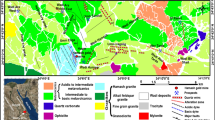Abstract
Remote monitoring of active lava domes provides insights into the duration of continued lava extrusion and detection of potentially associated explosive activity. On inactive flows, variations in surface texture ranging from dense glass to highly vesicular pumice can be related to emplacement time, volatile content, and internal structure. Pumiceous surface textures also produce changes in thermal emission spectra that are clearly distinguishable using remote sensing. Spectrally, the textures describe a continuum consisting of two pure end members, obsidian and vesicles. The distinct spectral features of obsidian are commonly muted in pumice due to overprinting by the vesicles, which mimic spectrally neutral blackbody emitters. Assuming that this energy combines linearly in direct proportion to the percentage of vesicles, the surface vesicularity can be estimated by modeling the pumice spectrum as a linear combination of the glass and blackbody spectra. Based on this discovery, a linear retrieval model using a least-squares fitting approach was applied to airborne thermal infrared data of the Little Glass Mountain and Crater Glass rhyolite flows at Medicine Lake Volcano (California) as a case study. The model produced a vesicularity image of the flow with values from 0 to ∼70%, which can be grouped into three broad textural classes: dense obsidian, finely vesicular pumice, and coarsely vesicular pumice. Values extracted from the image compare well with those derived from SEM analysis of collected samples as well as with previously reported results. This technique provides the means to accurately map the areal distributions of these textures, resulting in significantly different values from those derived using aerial photographs. If applied to actively deforming domes, this technique will provide volcanologists with an opportunity to monitor dome-wide degassing and eruptive potential in near-real-time. In July 1999 such an effort will be possible for the first time when repetitive, global, multispectral thermal infrared data become available with the launch of the Advanced Spaceborne Thermal Emission and Reflectance Radiometer (ASTER) instrument aboard the Earth Observing System satellite.
Similar content being viewed by others
Author information
Authors and Affiliations
Additional information
Received: 25 June 1998 / Accepted: 14 December 1998
Rights and permissions
About this article
Cite this article
Ramsey, M., Fink, J. Estimating silicic lava vesicularity with thermal remote sensing: a new technique for volcanic mapping and monitoring. Bull Volcanol 61, 32–39 (1999). https://doi.org/10.1007/s004450050260
Issue Date:
DOI: https://doi.org/10.1007/s004450050260




